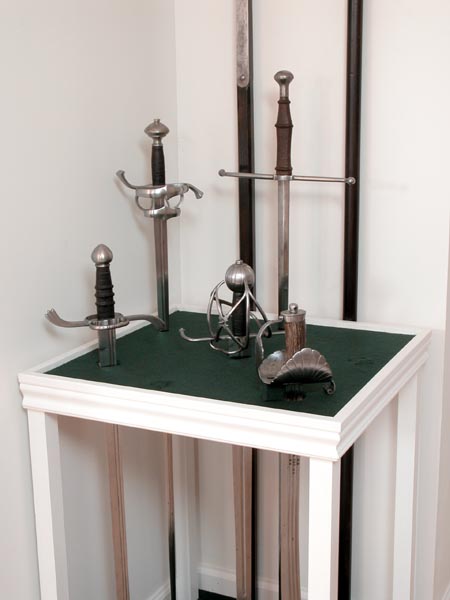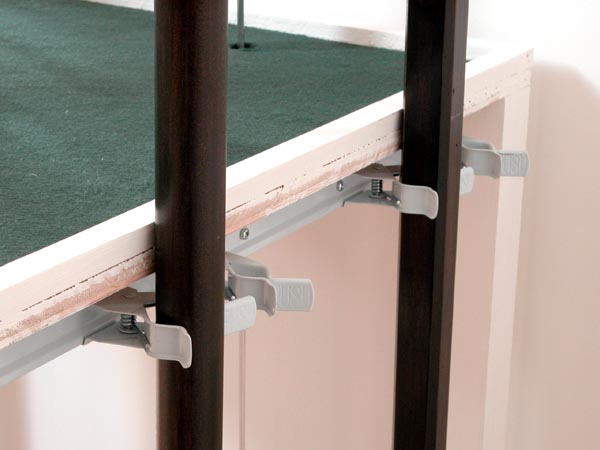I’m selling my custom arms and armour display. I designed and built this very carefully, with the demands of a diverse and rapidly changing collection in mind. It has served me very well. The only reason I’m selling it is because it can’t do one important thing—be a bookcase. I need the book space, so I now have to design a combination bookcase/a&a display. But my new design challenge is your opportunity if you live in or pass through the Birmingham, Alabama, area.
I ask only $50 for this unique display. Cash, check or money order. The catch is that I want to avoid shipping it. The buyer can pick it up at my house in north Jefferson Co. or I can bring it to my Homewood workplace and transfer it to you there. I’m willing to deliver the piece in either of those areas. If any prospective buyers are interested in my south German halberd and 15th c. spear, I’ll add those for a total price—polearms and display—of $200. PM for details on the polearms.
• All weapons are held securely
• All weapons are readily accessible
• All significant parts of the weapons are visible
• The display fits in corner
• Low profile puts attention on the collection, low center of gravity aids stability
Swords: Up to seven swords or rapiers may be displayed at one time. Two one-inch diameter bays are intended for rapier and similar blades). Five two-inch diameter bays serve most other swords. Each bay is completely covered by the green felt top surface, with flaps cut so that the material can be folded up when a bay is not in use. The bays are circular, so the swords can be turned in any direction. The tips of the swords are unrestricted and may be positioned as desired. The display comes with a felt-covered accessory block to allow neat display of a short, asymmetrically-hilted sword such as the EBE hanger shown here. The block supports one side of the hilt so the blade will hang straight down and is almost invisible.
Polearms: Up to four polearms may be displayed via a rack with sliding spring clamps. Because the clamps slide, you can maintain attractive spacing between the weapons. Because the polearms are removed straight out rather than up, ceiling clearance isn’t an issue. The polearms are locked in on three sides and the strong clamps holding them clear the wall by only a fraction of an inch. Even if a clamp fails, its parts should block the polearm's only exit. These clamps are made to hold axes, shovels and other suburban polearms, so there’s no misapplication or abuse of the technology involved here. They’re doing the job they were designed to do. A narrow ledge keeps the base of the polearms off the floor and allows the weapons to move with the display. Low-profile glider feet on the bottom of the display allow easy access to the polearms. You simply slide the display forward a few inches and unclip the weapon.
Versatility The old photo below shows an all-arms configuration. I currently display a burgonet in the lower part of the display and a sallet and bevor set in the center of the top, with three swords arrayed around the edges. The felt surface of the top also makes a wonderful background for the display of daggers or gauntlets.
Construction and Finish:Because the back and one side of the display rest very close to walls, there are only two pieces of molding along the top edge and two along the bottom edge. Strips of wood along the wall sides give the illusion that the molding extends fully around the display.
Top and bottom are (IIRC) ¾” birch plywood. Legs are poplar 2x2. Decorative molding is pine.
The felt is dark green. The paint is semigloss off-white (Magnolia). The colors beautifully complement the common colors of arms and armour--bright steel, brass, brown, black and red leather strapping.
The display is assembled with drywall screws, my preferred method for bookcase construction. The screws hold tighter than nails, keeping the frame stiff and stable, and can’t loosen over time or with repeated motion. The eight principal screw heads are covered by felt. The molding is attached with glue and countersunk finishing nails. Nail holes and miter joints are filled, sculpted and sanded.



